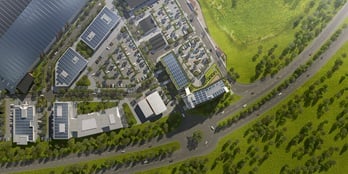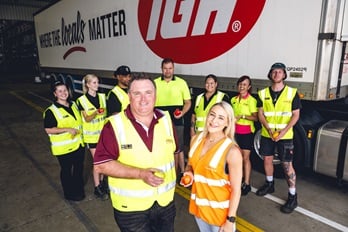UAV technology poised for widespread commercial adoption
By proceeding you confirm that you are a resident of Australia or New Zealand accessing this website from within Australia or New Zealand and you represent, warrant and agree that:
- you are not in the United States or a “U.S. person”, as defined in Regulation S under the U.S. Securities Act of 1933, as amended (“U.S. Person”), nor are you acting for the account or benefit of a U.S. Person;
- you will not make a copy of the documents on this website available to, or distribute a copy of such documents to, or for the account or benefit of, any U.S. Person or any person in any other place in which, or to any other person to whom, it would be unlawful to do so; and
- the state, territory or province and postcode provided by you below for your primary residence in Australia or New Zealand are true and accurate.
Unfortunately, legal restrictions prevent us from allowing you access to this website. If you have any questions, please contact us by e-mail by clicking on the link below.
Australian company Domino’s made world headlines with the first-ever pizza delivery by a drone in 2016.
That was essentially a publicity stunt, but Australia is now in the news again for a far more significant milestone after Project Wing, owned by Google’s parent company Alphabet, won approvals in April to begin commercial unmanned aerial vehicle (UAV) deliveries both here and the US.
That followed a ground-breaking trial Wing conducted over 18 months in Canberra that saw thousands of flights completed, and the company has been now cleared to conduct deliveries to five suburbs in Canberra, as well as to two rural communities in Virginia, US.
Australian drone expert Greg Boyer says Wing’s successes show that the final hurdles to widespread adoption of commercial UAV technology are falling rapidly, and the industry is now at a tipping point and poised for explosive growth.
Boyer, managing director of Sydney-based commercial drone consultancy firm Drone Ranger, believes the disruption UAVs will bring is not yet widely appreciated in this country.
“Australia’s business sector is not yet awake to the potential of this technology and is not adopting it at the same rates as we see overseas,’’ he says.
“Locally we have seen take-up for uses such as building inspections, and scanning barcodes and RFID tags for warehouse inventory management, but the field is developing so fast, and in so many directions.
“For example, within five years you will be able to sit in an office in, say, Brisbane while managing a project in Fiji, where your drone will automatically - or on command - pop out of its box, fly a programmed route recording photos and video, return home, recharge itself and upload data on the status of the project or asset, which can then be assessed against contract program and scope.’’
Wing’s approval to operate commercially in Canberra has been granted by the Civil Aviation Safety Authority subject to strict conditions – including restricting flights to daylight operating hours, and prohibiting them from crossing over major roads.
But the genie is out of the bottle, and Wing predicts drones could deliver more than one in four take-away food orders, and up to 6 per cent of all household purchases, in the ACT by 2030.
While the drones used by Wing in testing had a maximum payload of 1.5kg, UAVs capable of carrying a 150kg payload for 20 minutes are commercially available today.
Boyer says the two major problems that have long hindered widespread commercial UAV uptake – the ability to guarantee safety, and a lack of agreed operating rules – are now being solved.
“With work such as what Wing has done in Canberra, the world is now slowly gathering statistics to prove the technology is safe, and capabilities such as obstacle avoidance are becoming very advanced,’’ he says.
“At the same time NASA, in partnership with the FAA, as well as other organisations have developed unmanned traffic management systems that govern things such as flight paths and air lanes. Currently drones have no transponders and no sophisticated air rules, but that is about to change.’’
UAV delivery has already proved effective in less strictly regulated environments, and Unicef is trialling their use for delivery of vaccines in several African and Asian countries.
Zipline, a California-based company, recently launched the world’s largest drone drone delivery network in Ghana. Its fleet of 120 UAVs will transport medications, vaccines and blood products between 2000 health facilities across the country, operating 24/7.
Boyer points to commuting as another area that will be disrupted by drones much earlier than is widely appreciated.
“I know it sounds like something out of the Jetsons, but it’s not,’’ says Boyer. “In not too distant future, people will go to roof of a CBD building and use an app to summon a drone instead of a car.’’
He points to the UAVs produced by Chinese drone manufacturer Ehang, which together with Austrian aeronautics firm FACC recently announced they will begin commercial production in Europe next year of an autonomous ‘air taxi’ capable of carrying two people up to 35 kilometres at low altitudes.
Austrian Transport Minister Norbert Hofer says he hopes Austria will be among the first countries to have drone taxis flying regularly in its cities. Such a UAV, which can fly for 30 minutes at speeds of up to 130 km/h while carrying 260kg, also has obvious applications in logistics once licensed to operate widely.
With a 17 kilowatt battery, the Ehang UAV’s energy consumption per journey is comparable to that of an electric car in an urban environment, and a 2018 study in the journal Nature found that electric drones were “far more efficient than trucks, vans, larger gasoline drones and passenger cars” when comparing for distance travelled.
Boyer says Drone Range can barely keep up with demand for its services from companies wanting to integrate UAVs into their operations, but he fears Australia is missing out on a larger opportunity to become involved in the real growth area, UAV management systems.
“The future is not about operating drones, but about managing them—we need to catch up,’’ he says.


